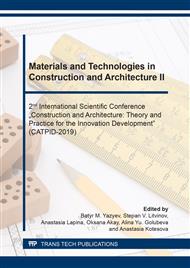p.676
p.681
p.687
p.693
p.698
p.704
p.711
p.718
p.723
The Concrete Diagrams Integral Parameters in the Calculations of Reinforced Concrete Elements by Limiting States
Abstract:
The paper proposes a method for calculating the reinforced concrete elements strength according to the deformation model using the deformation diagrams of concrete and reinforcing steel materials, which eliminates the complicated procedure of numerical integration of stresses in the element section during the transition to generalized internal forces. Integral parameters of diagrams are introduced into the energy model for calculating the strength of reinforced concrete elements along with the deformations and stresses normalized values at the base diagrams’ points. The integral parameters are calculated for the element cross section, the strain at the stress diagram gravity center in the compressed concrete zone and the coordinates of force in the concrete and reinforcement are relative to the neutral axis from the condition of the stress profile shape compliance in the element compressed zone, and the concrete diagram is used in the calculations. The integral parameters calculated dependences for the compressive strength concrete classes. The recommendations on the concrete diagrams integral parameters values rationing and their use in the complex sections and statically indeterminable systems calculations are given.
Info:
Periodical:
Pages:
698-703
Citation:
Online since:
December 2019
Authors:
Price:
Сopyright:
© 2020 Trans Tech Publications Ltd. All Rights Reserved
Share:
Citation:


